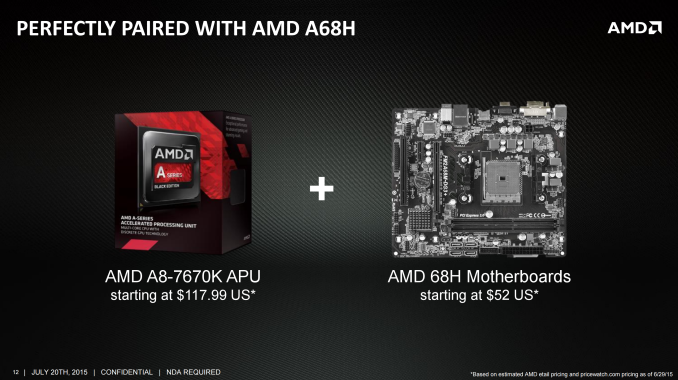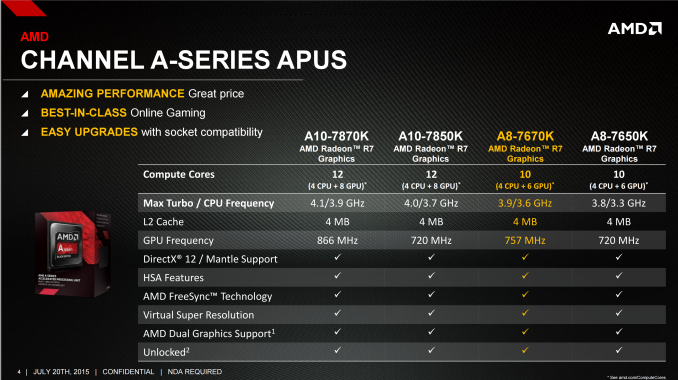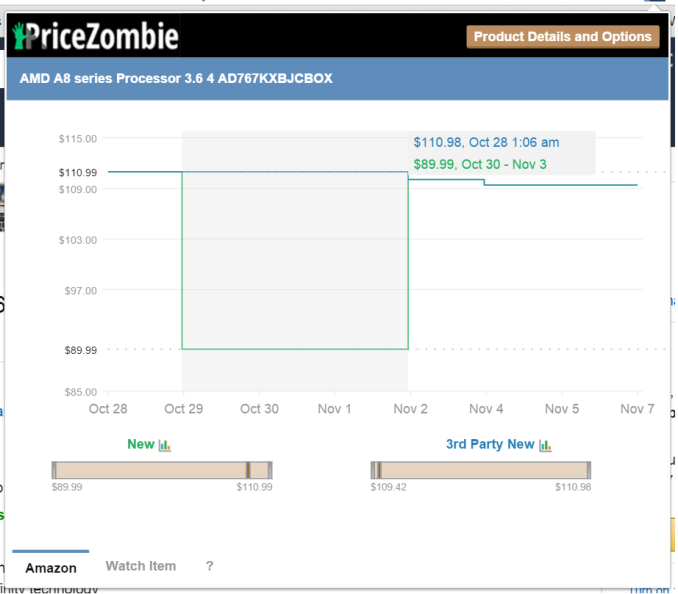The AMD A8-7670K APU Review: Aiming for Rocket League
by Ian Cutress on November 18, 2015 8:00 AM EST
Over the past couple of years, AMD has slowly released their mainstream brand of Kaveri processors. In turn, we have reviewed them, and they consistently aim to provide a midrange integrated gaming option, especially for those on a budget. The recent release of the A8-7670K was perhaps not that exciting, as AMD is filling up their product stack with new parts, taking advantage of an improved manufacturing process and aggressive binning. To that end, we're taking a different tack with this review. Alongside the regular tests, we also corralled Rocket League (an amazingly simple yet popular take on car football/soccer that sits on the precipice of e-sports glory) into a benchmark aimed at those sub-$600 gaming systems.
The AMD A8-7670K
Earlier this year, AMD announced their new line of Kaveri Refresh processors, starting with the A10-7870K (which we reviewed here). As the name suggests, these are Kaveri processors at their core, still based on the combination of Steamroller processor cores and 2nd generation Graphics Core Next (GCN) microarchitecture for graphics. These new refresh models are designed to take advantage of minor improvements in manufacturing, resulting in the ability to get higher clock speed for the same power consumption, even 18 months after the first Kaveri processors hit the scene. As a result, these Refresh processors — or, to use AMD's internal code name, "Godavari" — fill in the blank spots in the product stack and supersede the older parts, with the aim of squeezing in more frequency and performance for the same power consumption. It sounds deceptively simple — improve your process, refresh the part at the same price, and reap the benefits.
If we look at AMD's current lineup, we see that this new A8-7670K surpasses the older A10-7700K on the specification sheet, and comes in cheaper when brand-new.
| AMD Kaveri Lineup | ||||||||
| A10- 7870K |
A10- 7850K |
A10- 7800 |
A10- 7700K |
A8- 7670K |
A8- 7650K |
A8- 7600 |
X4 860K |
|
| Price | $137 | $134 | $131 | $120 | $118 | $104 | $89 | $85 |
| Modules | 2 | 2 | 2 | 2 | 2 | 2 | 2 | 2 |
| Threads | 4 | 4 | 4 | 4 | 4 | 4 | 4 | 4 |
| Core Freq. (GHz) | 3.9-4.1 | 3.7-4.0 | 3.5-3.9 | 3.4-3.8 | 3.6-3.9 | 3.3-3.8 | 3.1-3.8 | 3.7-4.0 |
| Compute Units | 4+8 | 4+8 | 4+8 | 4+6 | 4+6 | 4+6 | 4+6 | 4+0 |
| Streaming Processors |
512 | 512 | 512 | 384 | 384 | 384 | 384 | N/A |
| IGP Freq. (MHz) | 866 | 720 | 720 | 720 | 754 | 720 | 720 | N/A |
| TDP | 95W | 95W | 65W | 95W | 95W | 95W | 65W | 95W |
| DRAM Frequency |
2133 | 2133 | 2133 | 2133 | 2133 | 2133 | 2133 | 1866 |
| L2 Cache | 2x2MB | 2x2MB | 2x2MB | 2x2MB | 2x2MB | 2x2MB | 2x2MB | 2x2MB |
As it stands, the A8-7670K is a dual-module 3.6 GHz base frequency processor with a boost frequency up to 3.9 GHz. It comes with six graphics compute units, which translates to 384 streaming processors, similar to other A8 parts, but at a slightly higher IGP frequency of 754 MHz. The combined increase in processor and integrated graphics frequencies come at no extra cost in thermal design, with the A8-7670K at the same 95W TDP.
One of AMD's marketing strategies with these ~$100 processors is the price/performance angle. Aside from the integrated graphics, each of the AMD processors can pair with an R7 240 or R7 250 graphics card (DDR3 or GDDR5; AMD suggests an R7 250 GDDR5, as you might expect) in a hybrid dual graphics scenario, boosting performance. Thus, for the same price as an APU and an R7 250 graphics card, on average, AMD aims to offer a better gaming experience — especially for games that run at around 60 frames per second on medium settings — than a similarly priced Intel + NVIDIA platform. We've seen this marketing spiel corroborated in previous reviews, and would expect not to see anything different here. At launch, AMD put a $118 price on the A8-7670K, which, in recent sales, has been pushed down to under $100 at times.
The A8-7670K is an FM2+ socket processor, and thus requires either an A88X, A85X, A78 or A68 motherboard to go with it in order to take full advantage. As part of the launch, and given that this processor is a slightly boosted A8-7650K, AMD sees value in pairing it with something like a $50 A68H motherboard, making an APU+MB combination around $150 when on sale. However, as one might imagine, due to the age of the FM2/FM2+ socket, there are relatively few "new" motherboards on the market. The last one we reviewed was MSI's A88X-G45 Gaming, which brought over some of the components seen on its new Intel gaming motherboards, but other manufacturers have also put out M.2 capable AMD chipset-based motherboards as well.













154 Comments
View All Comments
Drumsticks - Wednesday, November 18, 2015 - link
If AMD really could get a 40% single threaded performance boost on their CPUs for Zen, and they can do it no later than Kaby Lake, then they really might get a moment to breath. That puts single threaded performance right around Intel's i3 parts, and would put multi-threaded performance (and likely graphics although that's a different story) well ahead. It's not going to take back the desktop market overnight, but it would be enough to get PC builders and maybe some OEMs interested and get enough volume moving for them to survive.Even if we budget a 10% IPC boost for Intel in Kaby Lake, that puts their i3's barely ahead, and still probably significantly behind in multi threaded performance compared to a 4 core Zen part. Here's hoping for an AMD recovery! I'd love to recommend AMD parts in more than just the $300 region now. Even if Zen only gets a single OEM to genuinely notice AMD, it will be an improvement.
V900 - Wednesday, November 18, 2015 - link
You seriously think AMD is going to sell a 4 core Zen processor for the same amount that a dual core Intel i3 sells for?In that case I got a bridge to sell you!
Make no mistake, AMD doesn't sell cheap APUs out of the goodness of their hearts.
The reason they're the budget option is because they don't have anything remotely competitive with Intel's Core CPUs, and therefore only can compete on the very low end of the market.
If their Zen core turns out to be on par with an intel processor, they'll sell it at the prices Intel charges, or slightly lower.
You won't see a quadcore Zen selling for roughly the same price Intel charges for an I3. You'll have AMD selling their quadcore Zen for the same 300$ Intel charges for an i5
yankeeDDL - Wednesday, November 18, 2015 - link
I don't fully agree.Yes, AMD's IPC is much lower than Intel's, and there's a gap in energy efficiency (although, much reduced with Carrizo).
But, as you correctly indicate, AMD prices they chip accordingly. So at ~120usd, the A8/A10 are extremely attractive, in my opinion. For home users, which have the PC on on a relatively small fraction of the time, having more cores, and an excellent GPU (compared to intel's at those price point) is quite beneficial.
Skylake changes things a bit, but up to Haswell (included) the performance of Intel's Core i3 in the low $100s, was easily beaten.
Dirk_Funk - Wednesday, November 18, 2015 - link
I don't think he/she said a single word about how zen would be priced. I don't know why you responded this way. Also, i5 sells for like $200-$250.Aspiring Techie - Wednesday, November 18, 2015 - link
If Zen is as good as advertised, then AMD can afford to increase the price of their CPUs by 20%. This would make their quad-cores in the $130-150 range, way cheaper than Intel's i5s. Granted, even Zen won't be as good as Kaby Lake. If AMD's performance per clock is 60% of Intel's, then Zen's will be about 84% of Intel's. Add in that a much better power efficiency (because the microarchitecture will have fewer pipeline stages) and possibly more cache with the smaller process node and you get roughly 85% i5 performance for $30 less. This doesn't even consider their APUs, which still could be priced at near i3 levels. They would beat the crap out of i3s and sometimes i5s (if HSA is utilized).Bottom line: Zen is AMD's last chance. AMD probably won't make the stupid mistake of pricing their CPU's too high. If they do, then bye-bye AMD for good.
JoeMonco - Wednesday, November 18, 2015 - link
"Bottom line: Zen is AMD's last chance. AMD probably won't make the stupid mistake of pricing their CPU's too high. If they do, then bye-bye AMD for good."Because if AMD is known for anything it's for its great business decisions. rofl
medi03 - Thursday, November 19, 2015 - link
Yeah, that's why they are in both major consoles at the moment, because of the "bad" business decisions.Klimax - Thursday, November 19, 2015 - link
There's a reason why Intel was uninterested in consoles. AMD barely makes any money on them...Kutark - Thursday, November 19, 2015 - link
^ This. Being in the consoles is because it was a massive volume order of parts and MS and Sony are looking to save as much as possible, fractions of a dollar per part matter when you're paying for literally millions of parts.anubis44 - Sunday, November 29, 2015 - link
The consoles are still providing AMD with a solid, baseline income every year, and their presence in consoles also make games easier to port to AMD's architecture, something that will become more apparent with DX12, since consoles are already using a DX12/Mantle-like API. AMD's decision to sweep the consoles and push Intel and nVidia out of them will have longer term reprocussions than many realize. AMD is also almost certain to win the next generation of consoles, too, with Zen-based APUs and Greenland-type graphics with HBM. In fact, AMD will probably release something like that for the mainstream PC market by 2017 and nVidia will be relegated to only the high-end of add-in graphics: AMD will be putting solidly mainstream graphics into their APUs, and an add-in mainstream AMD card will simply crossfire with the built-in graphics.